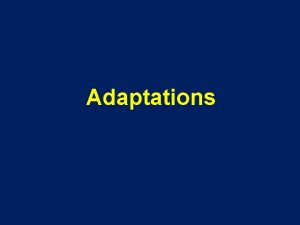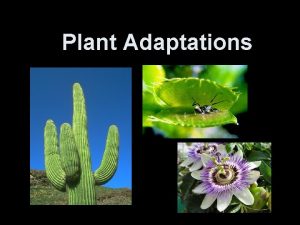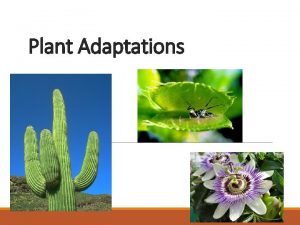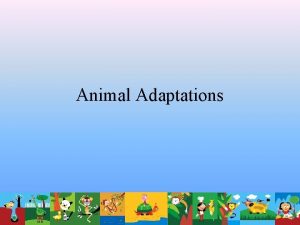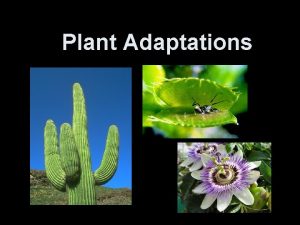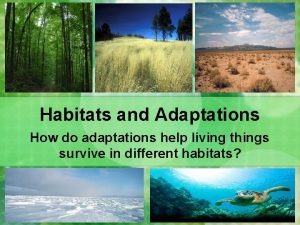Adaptations 5 1 Living Places Adaptations Adaptations To














- Slides: 14

Adaptations 5. 1 Living Places

Adaptations

Adaptations To survive in their habitat, organisms have adaptations. Adaptations are characteristics that assist organisms to survive and reproduce. Adaptations enable animals to: Adaptations protect themselves from predators (camouflage) survive hot and cold temperatures catch and eat food survive wet and dry seasons take in oxygen move from place to place (flippers, legs, wings) reproduce

How do animals adapt to arid/dry conditions long eye lashes, hairy ears and closing nostrils help to keep out sand thick eyebrows which stand out and shade eyes from the sun wide feet so they don’t sink in the sand they can go without water for over a week because they can drink gallons in one go they can go months without food – they store fat in their humps body temperature can change to avoid losing water through sweating they are well camouflaged thick fur helps to keep them warm at night

Adaptations enable plants to: Adaptations protect themselves from grazing animals (spines and thorns) capture light (large leaves) take in oxygen and carbon dioxide take in water (very long roots) reproduce

How do plants adapt to arid/dry conditions thick, waxy skin to reduce loss of water and to reflect heat large, fleshy stems to store water thorns and thin, spiky or glossy leaves to reduce water loss spikes protect cacti from animals wishing to use stored water deep roots to tap groundwater long shallow roots which spread over a wide area plants lie dormant for years until rain falls

A physical feature/characteristic that an organism has that helps it survive in its environment The way an organism’s body part are built to help it survive. Structural Adaptations Examples: Small ears on an arctic fox Kangaroo pouch Colour to camouflage Sticky pads on gecko feet Spines on cactus plant Wings for flight Body coverings, spikes on echidna Arctic foxes have thicker fur for surviving the freezing temperatures; Camels have long eyelashes and the ability to close their nostrils to keep sand out.

Something a species does/behaves in order to survive in its natural environment The way the organism acts to help it to survive. Behavioural Adaptations Behavioural adaptations can be instinctive or they can be learned. Instinctive behaviour is a behaviour pattern that the organism naturally follows. Examples: Breeding times Mating calls Nesting Migration Hibernation Hunts at night

Functional adaptations refer to the working of an organism's body involving internal body systems. These adaptations relate to the general functioning of the body. Functional Adaptations The way an organism’s body works to help it survive. Examples: Bilby sense of smell Echidna produces sticky saliva Little urine to save water Keep a constant temperature Make venom or slime

Adaptations of the emperor penguin

Adaptations of the artic fox

Adaptations of the barn owl

Summary and Case Study: Peppered Moth

Your task Complete cut and paste activity à Identify the adaptations as structural, behavioural or functional Answer 5. 1 review questions on page 190: Q 4, 15
 Living and nonliving things venn diagram
Living and nonliving things venn diagram Moss living or nonliving
Moss living or nonliving Living non living dead
Living non living dead What is the smallest living unit of life
What is the smallest living unit of life Going places ar barton
Going places ar barton Locating places on earth
Locating places on earth Nouns ideas persons places things
Nouns ideas persons places things How many places have you traveled to
How many places have you traveled to Going places safely
Going places safely Courting-places meaning
Courting-places meaning People and places
People and places People places leisure
People places leisure Round two decimal places
Round two decimal places Match the places with pictures
Match the places with pictures Bad manners synonym
Bad manners synonym















